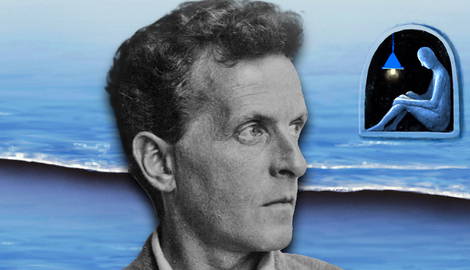
Wittgenstein’s first written work, Tractatus Logico-Philosophicus, was a project that aimed to show that if language was logically perfect, it would be able to represent reality completely. In doing so, we would see that most of philosophy’s most enduring questions are actually nonsense! In doing so, Wittgenstein also makes a compelling and unique argument for a new kind of solipsism. This article will give a general introduction to Wittgenstein’s Tractatus and his brand of logical solipsism.
Overview of the Tractatus Logico-Philosophicus

In the Tractatus Logico-Philosophicus, analytic philosopher Ludwig Wittgenstein claimed that he had solved all the problematic questions which have persisted without definitive answers in philosophy. It isn’t the case that the Tractatus formulated all of these questions and then proceeded to answer them; rather, Wittgenstein held that these problematic questions were the result of language speakers misunderstanding the logic of our language.
If one were to properly explain the logic of language to the poor soul driven to drink by questions of the problem of free will or immortality of his soul, he would see that the questions are meaningless – the problems disappear and are, therefore, effectively solved. No more questions means no more problems!
Wittgenstein’s Tractatus claims to solve all the questions of philosophy in this way – by dissolving them from our language.
The objective of the Tractatus is to show that “what can be said at all can be said clearly… [and] to draw a limit to… the expression of thoughts” (27).
In other words, Wittgenstein’s Tractatus is meant to limit language to what can only be said sensibly.
Any proposition, however grammatical, which does not fall within the limits of language is nonsense. Wittgenstein believes to have achieved this objective by first explicating the metaphysical structure of the world and then determining the conditions for a language that would be both logically perfect and entirely representative of the world.
This perfect language would be able to express everything within the world and nothing outside of it.
The World as I Found It

In the process of outlining the conditions for a logically perfect language, Wittgenstein comes to a spooky conclusion, which I’ll now refer to as the “Author’s Proposition,” about the ability (or, rather, inability) to sensibly express anything about the self:
“The thinking, presenting subject; there is no such thing.
If I wrote a book “The world as I found it,” I should also have therein to report on my body and say which members obey my will and which do not, etc. This then would be a method of isolating the subject or rather of showing that in an important sense there is no subject: that is to say, of it alone in this book mention could not be made” (5.631).
The upshot of this proposition in the Tractatus is that, if it is true, the self could not be represented in a language that is, in its totality, entirely representative of the world.
What would this mean? Well, either the self is not a part of the world and so is outside of it, or the self is not a part of the world because the self is the world, the latter being an argument for solipsism.
But to say that your thinking, conscious self is outside of the world is intuitively absurd. So, it seems that Wittgenstein was arguing for the latter – that the self is the world and solipsism is, effectively, true.
What is Solipsism?

Traditionally, solipsism is the idea that only one thing exists, and that thing is you.
All other people are figments of your imagination, created by you unconsciously. The world around you is dependent on your very existence. All that is outside of you is actually an extension of you. Without your “self,” there is nothing.
However, Wittgensteinian solipsism is not the same as the traditional notion of solipsism.
Here, it is helpful to distinguish how Wittgenstein uses “the world as I found it” and “The World.” The latter is independent of your existence. Without you, it still exists. The first is going to be identical with your existence. There is the independent “World,” and then the self’s “world” contained within it.
Unfortunately, Wittgenstein was not always very clear about what sort of world he was referring to, so this article will try to clarify whenever possible.
Now that the necessary distinctions have been made let’s get into what makes Wittgenstein’s solipsism so much more interesting!
The Limits of Language and the World

Wittgenstein asserts that “the limits of my language mean the limits of my world” (5.6) and that this logically perfect language and the world share a structure: logic.
Put another way, the limits of the world—the self’s world—are the exact same as the limits of logic. Logic does not say anything about what is or is not in the world, as that is not the role of logic. It is like scaffolding within, not something with access to a bird’s eye view. It will never tell you what the propositions within the world are.
Instead, logic shows what can be said of the totality of true and false propositions in the world (5.61).
To be a part of the world means to be an object represented by propositions in language. According to Wittgenstein, the proposition is a “picture of the world,” which is only true if a subject can compare and assert that the proposition’s logical form and the world’s logical form are the same.
So, a subject may find that she would like to sit and write this book from the Author’s Proposition. Writing this book, she would do what Wittgenstein says is philosophy – nothing more than “the logical clarification of thoughts” (4.112) by comparing propositions to the world.
At some point in the course of writing, the subject would be made aware of the existence of her “self” – necessarily so if she is doing a good job of it, since she would have to recognize it is her language, which is the limit of her world.
For a language that represents the world, there needs to be a representor of that language. That is her! And so, she can rest easy that language can represent the entire world and that she, the representor, exists.
Wittgenstein’s Solipsism

But alas, our subject runs into a spooky problem when it comes time to report her “self” in the book she is authoring.
Upon this realization that she exists, the subject would attempt to represent the proposition “for there to be a language which represents the world, there need be a representor of that language” and finds she cannot.
She can include propositions about “which members [of my body] obey my will and which do not” (5.631) but none that asserts the “self,” which is what Wittgenstein calls the “metaphysical subject.”
Why is this? Well, this proposition would require one to exceed the world’s limits for verification. Remember, to be a part of the world, you need to be able to express it as a proposition in logically perfect language and verify that its logical structure is identical to the physical world.
There is no way to verify her proposition that “for a language which represents the world, there needs to be a representor of that language” without removing the “self” from the world and taking a bird’s eye view from above.
As Wittgenstein so eloquently puts it,
“Our subject has discovered that she cannot be represented in language, and therefore she is not a part of the world. But in writing the book and engaging in the activity of philosophy, it has been made explicit that the metaphysical subject does exist, but not as an object in the world. Logically perfect language, as was stated above, cannot say what lies beyond its limits. If it cannot be said that the metaphysical subject is inside or outside the limits of the world, the conclusion our subject finds herself left with is that ‘the subject does not belong to the world but it is a limit of the world’” (5.632).
The author of the book is not mentioned in the book “The world as I found it” because there is no metaphysical subject found in “the world as I found it” – all that is found is my world, and I am its limit.
Final Remarks on Wittgenstein’s Solipsism

The world in its entirety might have a hard boundary, but this would only be known by getting outside the world. So one could not meaningfully say anything about the world as a bounded whole. However, within the boundary, “reality is limited by the totality of objects. The boundary appears again in the totality of… propositions” (5.5561).
Wittgenstein’s solipsism does not claim that the world, whose limit is the totality of objects and propositions, is the exact one of which the metaphysical subject is the limit. Rather, the limit of the metaphysical subject’s world is contained within the world limit of reality.
I cannot speak of the world as a whole because my individual experience can only approach this limit but never reach it – analogous to mathematical limits.
So, Wittgensteinian solipsism is one that “strictly carried out coincides with pure realism” (5.64).
One of the biggest concerns with the Tractatus is that, for a book that claims everything outside of the limits of language is nonsense, it sure does say a lot about the world as a whole – you know, outside of the limit of language!
With this in mind, I close with one last quote from Wittgenstein, “Whereof one cannot speak, thereof one must be silent” (7).










